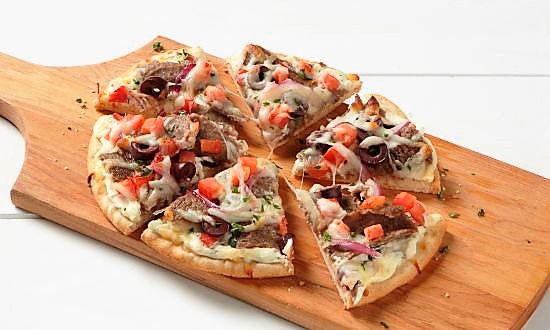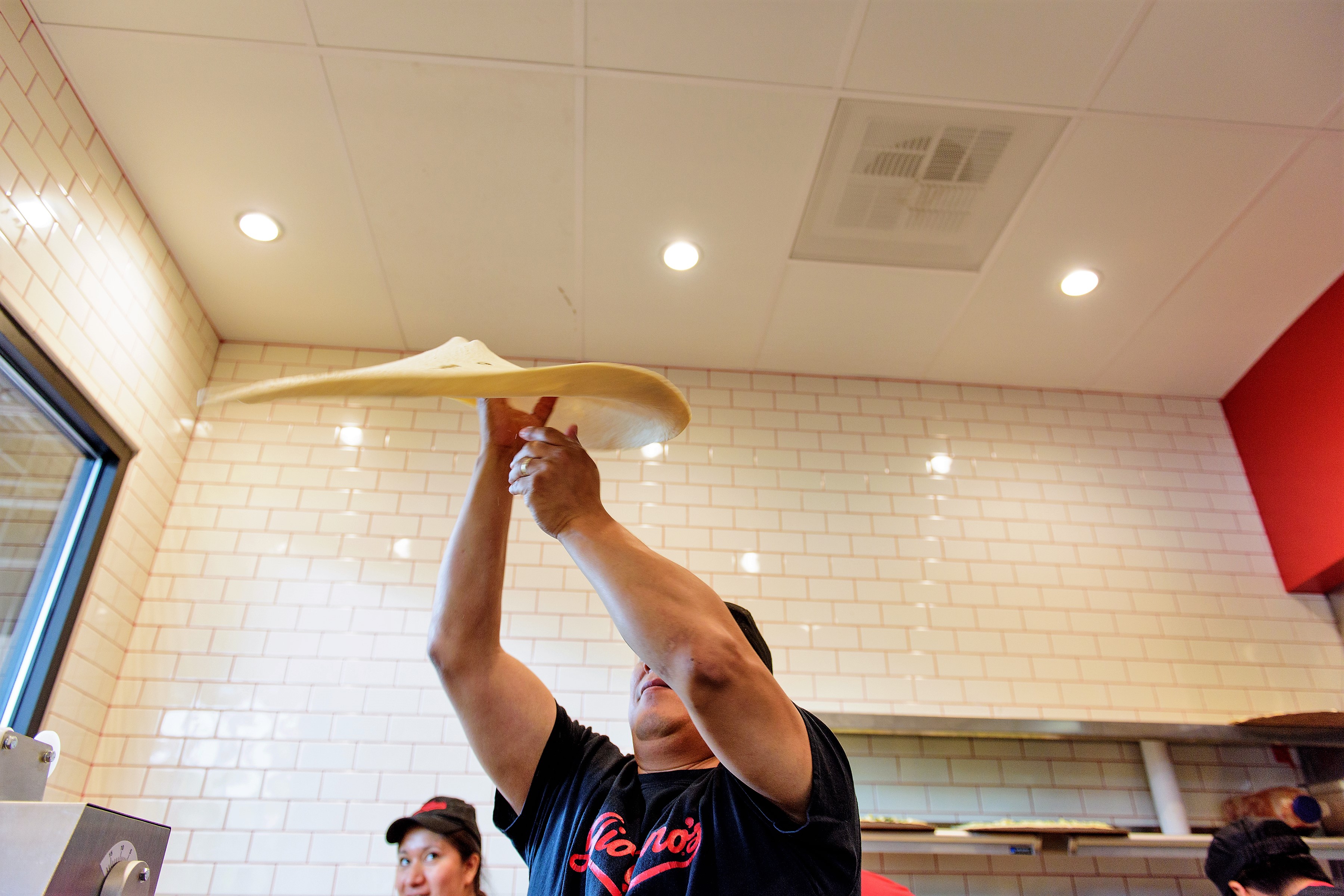Article
For the love of 'pítsa': Why more customers are turning to original Greek pies
This National Pizza Month, we thought it was worthwhile to remind folks that the very birthplace of pizza - Naples, Italy - actually used to be part of Greece thousands of years ago. And even at that early date, the folks in Naples were already making a version of pizza. Many brands are returning to the Greek version today.

October 17, 2018 by S.A. Whitehead — Food Editor, Net World Media Group
Say the word "pizza," and the immediate cultural connotation is Italian. But during this National Pizza Month, we thought it was worthwhile to remind folks that the very birthplace of pizza — Naples, Italy — actually used to be part of Greece thousands of years ago. And even at that early date, the folks in Naples were already making a version of pizza.
 |
| Giordano's customers chow down on a pie. Photo Giordano's. |
And still today, some restaurant brands — like Giordano's are including that historic version of "Grecian-inspired" pizza on their menus with a somewhat rabid fan base following close behind. In fact, according to Datassential MenuTrends, Mediterranean-style pizzas have increased their presence on the restaurant scene 4.8 percent over the last four years alone, with Greek pizzas growing 1.9 percent. It is, in short, a trend with legs.
We at Pizza Marketplace were intrigued by what you might call this "alternate" pizza culture, so we went to the experts on Grecian-styled pies at Grecian Delight, specifically Grecian Delight Director of Foodservice Marketing Catherine Porter. And for the restaurateur side of the story, we talked to Giordano's CEO Yorgo Koutsogiorgas. Between these two Greek cuisine experts, we got a nice look back into the history of the pie as the Greeks define it and a look ahead into the future of what some people just call "Greek pizza."
Q: Before its popular Italian manifestations, pizza was still a "thing" in many other Mediterranean nations, like Greece for a long time, correct? Can you tell us more about the pie's origins as flatbread or pita topped with other ingredients a la Greece?
Porter: Similar to the history of modern-day pizza that is believed to have originated out of Naples — which was founded as a Greek settlement — people of the Middle East, Greeks, Egyptians and Armenians were making some derivative of pizza in ancient times by cooking flatbreads in mud ovens. This was a thrifty and convenient food that was perfect for working men and their families. (Editor's note: Back then they were indeed all working "men," thus we are not simply being gender ignorant in that reference.)
This history of a "working man's food" is similar to the evolution (of pizza) out of Naples, where bakers used up extra dough by topping it with various ingredients and selling it to poor people.
"A traditional Greek pizza is made with olive oil, red onions, spinach, red pepper, Kalamata olives and feta. "
Q: How would you make a pizza as a "Greek pizza," per se?
Koutsogiorgas: Giordano's will use gyros slices in introducing a Greek pizza. Feta cheese will be added to the top and Tzatziki sauce will be offered as an option to dip the slices in. ... Giordano's uses extra virgin olive oil, imported from Greece ... Greek Feta cheese is used in salads and as a topping on pizzas. ... Our extra-thin spinach, artichoke and feta pizza is a big hit.
 |
| Traditional Greek pie with beef and lamb gyro. Photo Grecian Delight. |
Porter: A traditional Greek pizza is made with olive oil, red onions, spinach, red pepper, Kalamata olives and feta. This same ingredient combination is often "menu-ed" today under the description of a Mediterranean pizza. The difference we are seeing is that a Greek pizza may more often include gyro topping and a tzatziki sauce or dip accompaniment. ...
It is interesting that the ingredients used on most restaurants' Mediterranean and Greek-style pizzas are actually the same ingredients, just being (listed on menus) under two different names. The ingredients on these pizzas are just so synonymous with the Mediterranean because of Greece's influence on the foods of the region that today's consumer sees it as both a Greek and a Mediterranean pizza.
"Today Greek and Mediterranean pizzas are being added to more QSR menus than any other commercial segment, according to Datassential MenuTrends study."
Q: This question is aimed specifically at Grecian Delight because your company specializes in Greek food items, so I'm wondering if you are finding more companies ordering for ingredients for this type of pizza?
Porter: We do. ... Our Lavash and Naan flatbreads are popular bases for flatbread pizzas, as are our Pitas. ... Twenty-five percent of Mediterranean restaurants "menu" pizza, according to Datassential, so ingredients like pita or naan, feta or Tzatziki, gyro or shawarma are items they already carry and are also being used with the pizzas they are serving.
Restaurants and consumers alike are always excited by new ideas for pizza. This is an area that is so great for LTOs and new flavor introductions. ... Mediterranean flavors are hot on restaurant menus today. Millennial and Gen Z consumers are seeking out these international flavors when dining away from home. ...
 |
| A pizza begins at Giordano's. Photo Giordano's. |
Consumers love spicy sauces. Technomic reports that more than 50 percent of consumers seek very spicy sauces on menus, so thought should be given to offering a variety of sauces with pizza — an alternative to a classic tomato sauce that has more heat, or even adding a drizzle topping, like a Harissa ... can bring a new level of spice and flavor to the pizza.
Q: What types of customers would you say might be interested in trying a pie decked out in Mediterranean fare?
Koutsogiorgas: Giordano's customers trust Giordano's as a brand, and they are very interested in trying new offerings. A pizza featuring gyros meat as the main ingredient will be very well received. ... (and that) will definitely open up opportunities for educating Giordano's customers about Greek cuisine and Mediterranean ingredients in general.
There are many creative ways to use ingredients from the Mediterranean region in cuisines and recipes which are not related at all to that region (and) by doing so, one can widen the appeal of Mediterranean foods beyond the typical Greek or other ethnic restaurants.
Porter: An authentic Greek pizza or Mediterranean flatbread pizza is going to appeal to vegetarians (as well as) those looking to eat lighter without sacrificing flavors. Today Greek and Mediterranean pizzas are being added to more QSR menus than any other commercial segment, according to Datassential MenuTrends study. Overall penetration is high with casual dining and fast casual, but QSR is really what is growing, indicating great widespread consumer interest in these varieties.
About S.A. Whitehead
Pizza Marketplace and QSRweb editor Shelly Whitehead is a former newspaper and TV reporter with an affinity for telling stories about the people and innovative thinking behind great brands.





